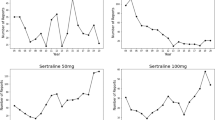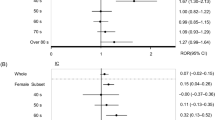Abstract
A limited number of studies have described patients on finasteride showing findings which were consistent with Peyronie’s disease (PD). We aimed to detect a pharmacovigilance signal of possible association between finasteride and PD-related clinical features. The Food and Drug Administration (FDA) Adverse Event Reporting System (FAERS) database was queried to identify the ten drugs which were associated the most with the adverse drug reactions (ADRs) recorded as “penile curvature” and/or “Peyronie’s disease”. A similar analysis, including the same drugs, was carried out for the EMA (European Medicines Agency) EudraVigilance (EV) database. Descriptive data have been analyzed, and Proportional Reporting Ratios (PRRs) have been computed against the other nine drugs of the database. Overall, 860 reports of “penile curvature” and/or “Peyronie’s disease”, were identified in the FAERS database, 214 of which (24.9%) were associated with finasteride. Most reports (56.9%) were submitted by healthcare professionals. Where a treatment-indication was stated, the vast majority of reports (176/210; 83.8%) were associated with androgenetic alopecia. The outcome of most ADRs was “serious” (82.2%), with 96 ADRs resulting in levels of permanent disability. For 97/214 individual cases, penile curvature/PD reports were not part of a syndromic cluster suggestive of post-finasteride syndrome (PFS). The PRR resulted 6.6 (95% CI: 5.6–7.8) and 11.8 (95% CI: 9.08–15.33), respectively, in the FAERS and in the EV databases. Notwithstanding the related limitations and biasing factors of pharmacovigilance studies based on spontaneous reporting, the PRR values here identified should be interpreted as strong signals of disproportionality. These findings, per se, are however not useful to confirm any causal association. Clinical studies are needed to investigate on the possible role for finasteride in causing PD-related clinical features, an hypothesis which remains highly speculative due to the very questionable quality of present data.
This is a preview of subscription content, access via your institution
Access options
Subscribe to this journal
Receive 8 print issues and online access
$259.00 per year
only $32.38 per issue
Buy this article
- Purchase on Springer Link
- Instant access to full article PDF
Prices may be subject to local taxes which are calculated during checkout

Similar content being viewed by others
References
Hussein AA, Alwaal A, Lue TF. All about Peyronie’s disease. Asian J Urol. 2015;2:70–8. https://doi.org/10.1016/j.ajur.2015.04.019.
Nelson CJ, Mulhall JP. Psychological impact of Peyronie’s disease: a review. J Sex Med. 2013;10:653–60. https://doi.org/10.1111/j.1743-6109.2012.02999.x.
Sharma KL, Alom M, Trost L. The etiology of Peyronie’s disease: pathogenesis and genetic contributions. Sex Med Rev. 2020;8:314–23. https://doi.org/10.1016/j.sxmr.2019.06.004.
Aditya I, Grober ED, Krakowsky Y. Peyronie’s disease and testosterone deficiency: Is there a link? World J Urol. 2019;37:1035–41. https://doi.org/10.1007/s00345-019-02723-9.
Ventimiglia E, Capogrosso P, Colicchia M, Boeri L, Serino A, La Croce G, et al. Peyronie’s disease and autoimmunity—a real-life clinical study and comprehensive review. J Sex Med. 2015. https://doi.org/10.1111/jsm.12825.
Mulhall JP, Matsushita K, Nelson CJ. Testosterone levels are not associated with magnitude of deformity in men with Peyronie’s disease. J Sex Med. 2019. https://doi.org/10.1016/j.jsxm.2019.05.021.
Candela L, Boeri L, Capogrosso P, Oreggia D, Cazzaniga W, Pozzi E, et al. Serum testosterone levels are not associated with the severity of penile curvature in men with Peyronie’s disease—findings from a cross-sectional study. Int J Impot Res. 2020. https://doi.org/10.1038/s41443-020-0340-7.
Sobel V, Zhu YS, Imperato-McGinley J. Fetal hormones and sexual differentiation. Obstet Gynecol Clin North Am. 2004;31:837–56. https://doi.org/10.1016/j.ogc.2004.08.005.
Shen ZJ, Zhou XL, Lu YL, Chen ZD. Effect of androgen deprivation on penile ultrastructure. Asian J Androl. 2003;5:33–6.
Traish AM, Park K, Dhir V, Kim NN, Moreland RB, Goldstein I. Effects of castration and androgen replacement on erectile function in a rabbit model. Endocrinology. 1999. https://doi.org/10.1210/endo.140.4.6655.
Ganzer CA, Jacobs AR, Iqbal F. Persistent sexual, emotional, and cognitive impairment post-finasteride: a survey of men reporting symptoms. Am J Mens Health. 2015;9:222–8. https://doi.org/10.1177/1557988314538445.
Traish AM. Post-finasteride syndrome: a surmountable challenge for clinicians. Fertil Steril. 2020;113:21–50. https://doi.org/10.1016/j.fertnstert.2019.11.030.
Garreton AS, Valzacchi GR, Layus O. Post-finasteride syndrome: about 2 cases and review of the literature. Andrology. 2016;5. https://doi.org/10.4172/2472-1212.1000170.
Montastruc JL, Sommet A, Bagheri H, Lapeyre-Mestre M. Benefits and strengths of the disproportionality analysis for identification of adverse drug reactions in a pharmacovigilance database. Br J Clin Pharmacol. 2011. https://doi.org/10.1111/j.1365-2125.2011.04037.x.
Schifano F, Chiappini S, Corkery JM, Guirguis A. An insight into Z-drug abuse and dependence: an examination of reports to the European Medicines Agency Database of suspected adverse drug reactions. Int J Neuropsychopharmacol. 2019. https://doi.org/10.1093/ijnp/pyz007.
Kumar A. The newly available FAERS public dashboard: implications for health care professionals. Hosp Pharm. 2019;54:75–7. https://doi.org/10.1177/0018578718795271.
EMA. Guideline on good pharmacovigilance practices (GVP) Annex I—Definitions (Rev 4). Heads Med Agencies; 2017.
Schifano N, Chiappini S, Castiglione F, Salonia A, Schifano F. Is medicinal ketamine associated with urinary dysfunction issues? Assessment of both the European Medicines Agency (EMA) and the UK Yellow Card Scheme pharmacovigilance database-related reports. Low Urin Tract Symptoms. 2021;13:230–7. https://doi.org/10.1111/luts.12355.
Chiappini S, Schifano F. A decade of gabapentinoid misuse: an analysis of the European Medicines Agency’s ‘Suspected Adverse Drug Reactions’ database. CNS Drugs. 2016;30:647–54. https://doi.org/10.1007/s40263-016-0359-y.
European Medicines Agency. Guideline on the use of statistical signal detection methods in the EudraVigilance data analysis system. 2008.
Grundmark B, Holmberg L, Garmo H, Zethelius B. Reducing the noise in signal detection of adverse drug reactions by standardizing the background: a pilot study on analyses of proportional reporting ratios-by-therapeutic area. Eur J Clin Pharmacol. 2014. https://doi.org/10.1007/s00228-014-1658-1.
Agency for Healthcare Research and Quality. Medical Expenditure Panel Survey, MEPS Data Files, Documentation, and Codebooks. n.d. https://meps.ahrq.gov/mepsweb/data_stats/download_data_files.jsp.
WHO. The WHO Programme for International Drug Monitoring. 2015.
Felicetti P, Trotta F, Bonetto C, Santuccio C, Brauchli Pernus Y, Burgner D, et al. Spontaneous reports of vasculitis as an adverse event following immunization: a descriptive analysis across three international databases. Vaccine. 2016. https://doi.org/10.1016/j.vaccine.2015.09.027.
Hoffman KB, Demakas AR, Dimbil M, Tatonetti NP, Erdman CB. Stimulated reporting: the impact of US Food and Drug Administration-Issued Alerts on the Adverse Event Reporting System (FAERS). Drug Saf. 2014;37:971–80. https://doi.org/10.1007/s40264-014-0225-0.
Rezende HD, Dias MFRG, Trüeb RM. A comment on the post-finasteride syndrome. Int J Trichology. 2018. https://doi.org/10.4103/ijt.ijt_61_18.
Lolli F, Pallotti F, Rossi A, Fortuna MC, Caro G, Lenzi A, et al. Androgenetic alopecia: a review. Endocrine. 2017;57:9–17. https://doi.org/10.1007/s12020-017-1280-y.
Bhatti HA, Basra MKA, Patel GK. Hair restoration approaches for early onset male androgenetic alopecia. J Cosmet Dermatol. 2013;12:223–31. https://doi.org/10.1111/jocd.12047.
Baas WR, Butcher MJ, Lwin A, Holland B, Herberts M, Clemons J, et al. A review of the FAERS data on 5-Alpha Reductase inhibitors: implications for postfinasteride syndrome. Urology. 2018;120:143–9. https://doi.org/10.1016/j.urology.2018.06.022.
Brenner S, Matz H. Improvement in androgenetic alopecia in 53-76-year-old men using oral finasteride. Int J Dermatol. 1999;38:928–30. https://doi.org/10.1046/j.1365-4362.1999.00804.x.
Walsh TJ, Hotaling JM, Lue TF, Smith JF. How curved is too curved? the severity of penile deformity may predict sexual disability among men with Peyronie’s disease. Int J Impot Res. 2013;25:109–12. https://doi.org/10.1038/ijir.2012.48.
Irwig MS. Persistent sexual side effects of finasteride: could they be permanent? J Sex Med. 2012;9:2927–32. https://doi.org/10.1111/j.1743-6109.2012.02846.x.
Gray SL, Semla TP. Post-finasteride syndrome. BMJ. 2019;366:9–10. https://doi.org/10.1136/bmj.l5047.
Wessells H, Roy J, Bannow J, Grayhack J, Matsumoto AM, Tenover L, et al. Incidence and severity of sexual adverse experiences in finasteride and placebo-treated men with benign prostatic hyperplasia. Urology. 2003;61:579–84. https://doi.org/10.1016/S0090-4295(02)02401-9.
Ellis JA, Stebbing M, Harrap SB. Polymorphism of the androgen receptor gene is associated with male pattern baldness. J Invest Dermatol. 2001. https://doi.org/10.1046/j.1523-1747.2001.01261.x.
Cauci S, Chiriacò G, Cecchin E, Toffoli G, Xodo S, Stinco G, et al. Androgen receptor (AR) gene (CAG)n and (GGN)n length polymorphisms and symptoms in young males with long-lasting adverse effects after finasteride use against androgenic alopecia. Sex Med. 2017;5:e61–71. https://doi.org/10.1016/j.esxm.2016.11.001.
Chew KK, Stuckey BGA, Earle CM, Dhaliwal SS, Keogh EJ, Porst H. Penile fibrosis in intracavernosal prostaglandin E1 injection therapy for erectile dysfunction. Int J Impot Res. 1997. https://doi.org/10.1038/sj.ijir.3900296.
European Medicines Agency. Xiapex product information form. 2020. https://www.ema.europa.eu/en/documents/product-information/xiapex-epar-product-information.
Author information
Authors and Affiliations
Contributions
Conception of the work: NS and FS; Data collection: NS, GF, SC, MR, OOC and HH; Data analysis and interpretation: NS, PC, LB, FC, HMA, AM, FD, FM, FS and AS; Drafting the article: NS, SC and FS; Critical revision of the article: PC, LB, GF, SC, MR, OOC, HH, FC, HMA, AM, FD, FS, FM and AS; Final approval of the version to be published: NS, PC, LB, GF, SC, MR, OOC, HH, FC, HMA, AM, FD, FS, FM and AS.
Corresponding author
Ethics declarations
Competing interests
FS is a member of the EMA Advisory board (Psychiatry). No further conflicts of interest are here declared.
Additional information
Publisher’s note Springer Nature remains neutral with regard to jurisdictional claims in published maps and institutional affiliations.
Rights and permissions
About this article
Cite this article
Schifano, N., Capogrosso, P., Boeri, L. et al. Are finasteride-related penile curvature/Peyronie’s disease Adverse Event Reports worthy of further clinical investigation? Disproportionality analysis based on both the Food and Drug Administration (FDA) and the European Medicines Agency (EMA) pharmacovigilance databases. Int J Impot Res 35, 465–471 (2023). https://doi.org/10.1038/s41443-022-00568-2
Received:
Revised:
Accepted:
Published:
Issue Date:
DOI: https://doi.org/10.1038/s41443-022-00568-2
This article is cited by
-
A clinical guide to rare male sexual disorders
Nature Reviews Urology (2024)
-
Finasteride-related Peyronie's disease
Reactions Weekly (2022)



